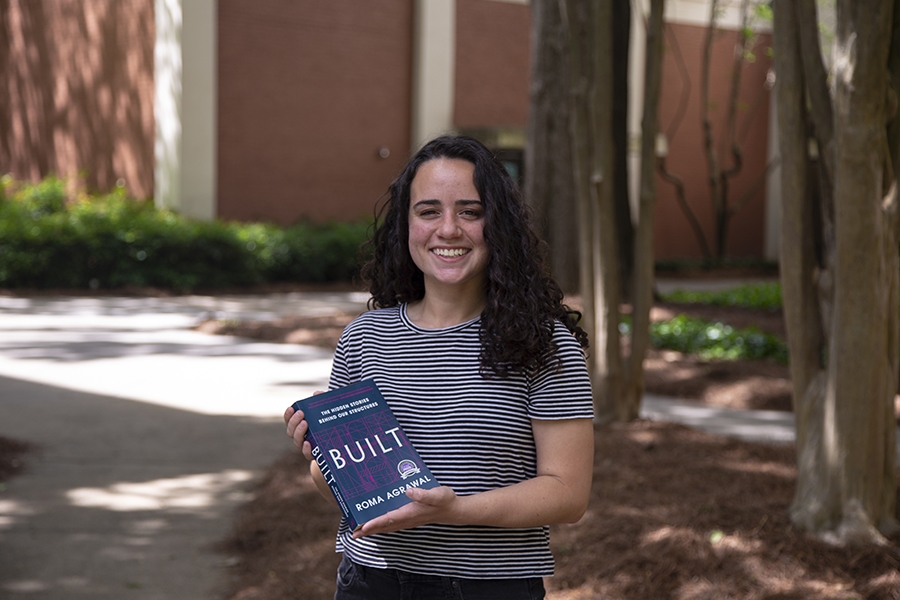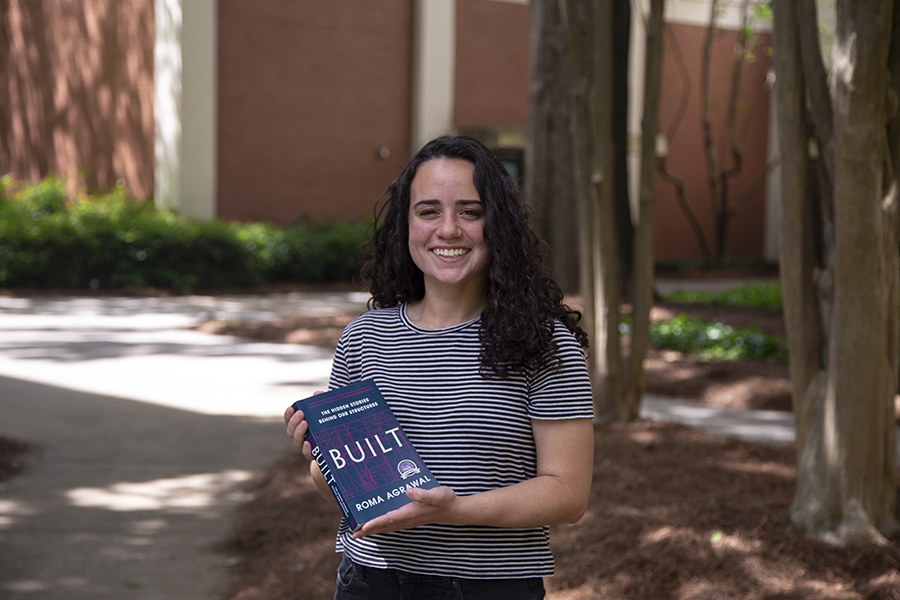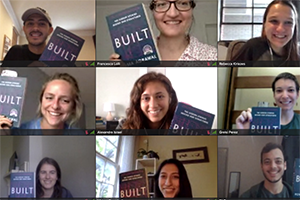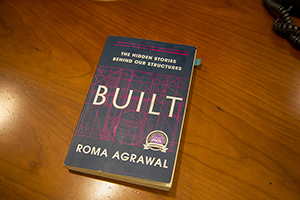
 |
| Maria Warren holds her copy of BUILT, the book she selected to kickoff the book club she created for the CEE Community. Photo: Amelia Neumeister |
By Melissa Fralick
As the pandemic dragged into 2021, Maria Warren found herself reading more and more.
With Covid-19 shelving her go-to leisure activities like playing soccer and meeting friends for coffee, the PhD student turned to books in her spare time and decided reread one of her favorites: BUILT by Roma Agrawal.
“This book made me fall in love with structural engineering again,” Warren said.
In 2020, Warren was selected as one of the School of Civil and Environmental Engineering’s Future Faculty Fellows. The four-year-old program supports students pursuing careers in academia through a $1,000 stipend to guide their development as educators and help them build their research and professional relationships.
But like soccer and coffee shops, Covid-19 took traveling to conferences off the table, and spending the money to attend virtual conferences just didn’t have the same appeal for Warren.
So she came up with the idea of bringing the CEE community together for a book club to read and talk about the book that had been so influential for her.
Using her Future Faculty Fellows stipend, Warren committed to purchasing a book for any student interested in participating. She also made the club up to everyone in CEE—students, faculty and staff—with the goal of creating a sense of community for the School during a time when so many were working and studying remotely.
With its accessible style and broad overview of structural engineering history, Warren thought BUILT would be the perfect way to kick off the book club.
 Members of the book club smiled for a virtual photo during the group's April 23 meeting. |
“It is technical, but it’s written for a beginner,” said Warren, who co-teaches an introduction to structural engineering for undergraduates. “This was a really good book because it’s for people who are not as experienced on the technical side, but also I love structural engineering and I’ve read it three or four times over.”
At the start of the Spring 2021 semester, Warren created a flyer and spread the word about the CEE Book Club. She joked about her initial worry that the club might just be her and a few friends that she guilted into joining. But it turns out that Warren was onto something: Lots of people signed up to participate, and roughly 30 people attended each virtual meeting.
While the book focused on structures, book club participants represented a cross-section of the School and included students from other disciplines like transportation and water systems engineering.
Tobias Kopp, a rising fourth year student, said he was intrigued by the book club’s focus on structural engineering—an area he didn’t know much about.
“The book club was an all-around amazing experience and I applaud Maria for getting the book club up and running during such a challenging time,” Kopp said. “I enjoyed hearing other students’ thoughts on the discipline, and one of the best things I took away were the amazing stories others shared of their experiences in structural engineering either from an internship or research.”
Francesca Lolli, a second-year post-doctoral researcher, said it was nice having the opportunity to interact with different people during the group discussions.
“Every time I met new people with very different backgrounds, so the conversation was always very stimulating,” Lolli said. “My take away is that we should probably integrate more ‘soft’ reading at the university level. I think that focusing on why we built cities in a certain way and how history is connected to the built environment is something that we don’t think enough about during more traditional courses.”
For the group’s last meeting of the semester, Warren decided to try something bold. She emailed Agrawal, the author of the book, and asked if she would be willing to join the virtual meeting and answer a few questions.
 BUILT: The Hidden Stories Behind Our Structures. Photo by Amelia Neumeister. |
To Warren’s delight, she said yes. Agrawal beamed in to the CEE Book Club’s April 23 meeting from her home in the United Kingdom, where she shared her career journey with the group and answered questions about sustainability, ethics and the future of civil engineering.
Agrawal is a structural engineer who has worked on several notable buildings in London’s skyline, including The Shard, the tallest building in western Europe. Agrawal said over the years, she gave lots of presentations about these high-profile projects, and found she had a knack for explaining complicated subject matter. She was approached by a publisher with an offer to write a book, which became BUILT: The Hidden Stories Behind Our Structures. The 2018 book combines history, technical explanations and personal anecdotes to explain the evolution of construction over time.
As an aspiring professor, leading the CEE book club gave Warren a new perspective on teaching.
“The book club has been super interesting because I’ve taught Introduction to Structures and Civil Engineering Materials, and those are really technical classes,” Warren said. “With the book club, I’m leading a discussion-based class. It’s been interesting to learn how to moderate discussions and ensure that everyone who wants to participate can. It’s been a challenge but it’s been a lot of fun.”
Following its successful debut, plans are underway for the book club to continue in the fall.
The basic structure will remain the same. The group will read one book and discuss it in several meetings over the course of the semester. But there will be one major change—participants will gather on campus instead of on their computer screens.
Warren hopes that the book club will continue to thrive and provide more opportunities for people in CEE to get to know each other and interact face to face.
“I feel really grateful to everyone in the CEE community who has supported and joined and shared it with their friends,” Warren said. “The participants in the book club are so enthusiastic and the discussions are so fulfilling. They’ve made the experience so great and I’m really grateful for them.”
Related:
- Future Faculty Fellows Bring Passion for Teaching, Research
- BUILT: The Hidden Stories Behind Our Structures
